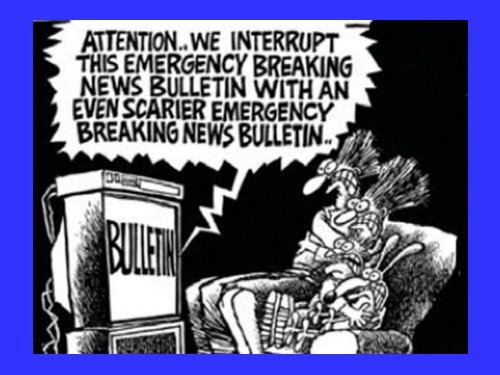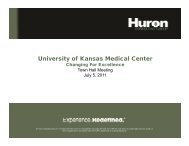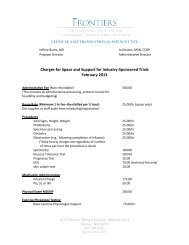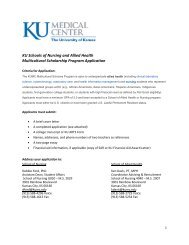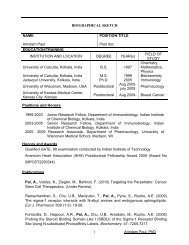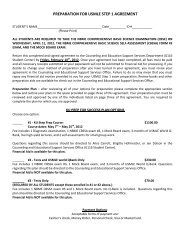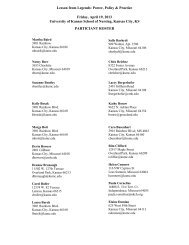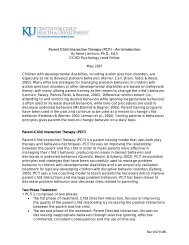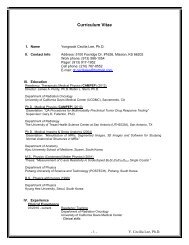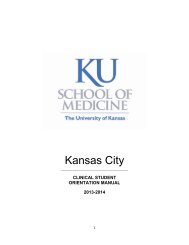Risk Communication/Media Relations
Risk Communication/Media Relations
Risk Communication/Media Relations
You also want an ePaper? Increase the reach of your titles
YUMPU automatically turns print PDFs into web optimized ePapers that Google loves.
<strong>Risk</strong> <strong>Communication</strong>s<br />
for HazMat Managers During a Crisis<br />
Mike Cameron – <strong>Risk</strong> <strong>Communication</strong>s Specialist<br />
Office of <strong>Communication</strong>s<br />
Kansas Department of Health & Environment<br />
1000 SW Jackson – Suite 550<br />
Topeka, KS 66612<br />
Phone: 785-368-8053<br />
Email: mcamero1@kdhe.state.ks.us
I’m not this Mike Cameron..
What would be<br />
your worst<br />
nightmare?
Illegal disposal of hazardous waste?
A train derailment ?
A terrorist attack using a<br />
chemical agent?
A half-eaten jar of Peter Pan peanut<br />
butter in your cupboard?
Experts say that if an event of national<br />
significance takes place in your area, as<br />
many as 1,000 reporters could show up<br />
within 4 hours.
Are you prepared to at least answer<br />
questions from the local media?
A communication plan that includes a set<br />
of positive key messages will aid you in<br />
getting the correct message to the public,<br />
through the media.
Old Style <strong>Communication</strong> Plan<br />
• First, answer phone call from a reporter.<br />
• Then, try to answer questions<br />
intelligently.<br />
• Finally, watch the TV news that evening<br />
and read the newspaper the next<br />
morning and see how it went.
<strong>Risk</strong> <strong>Communication</strong><br />
Definition<br />
“A Science-based<br />
Approach for<br />
Communicating Effectively in:<br />
High-Concern<br />
High Stress<br />
Emotionally Charged, or<br />
Controversial Situations”
Public Information vs. <strong>Risk</strong><br />
<strong>Communication</strong>s<br />
• Public Information: Day-to-day<br />
communication activities designed to<br />
provide accurate and timely information<br />
on a routine basis to the media.<br />
• <strong>Risk</strong> <strong>Communication</strong>: Providing accurate<br />
and timely information to educate and<br />
reassure the public during and after an<br />
unfamiliar event or emergency.
<strong>Risk</strong> <strong>Communication</strong><br />
Why Is It Needed?<br />
CRISIS<br />
+ Heightened<br />
public<br />
emotions<br />
+ Limited<br />
access to<br />
facts<br />
+<br />
rumor,<br />
speculation,<br />
assumption<br />
and inference<br />
=<br />
an unstable<br />
information<br />
environment
<strong>Risk</strong> <strong>Communication</strong> Gurus<br />
Vincent Covello, PhD<br />
www.centerforriskcommunication.com<br />
Peter Sandman, PhD<br />
www.psandman.com
Leading Authorities on <strong>Risk</strong><br />
<strong>Communication</strong><br />
• Peter Sandman, Ph.D.<br />
– Consulting, Training and Research in <strong>Risk</strong><br />
<strong>Communication</strong>s.<br />
– Theories based on crowd psychology.<br />
– Co-writes articles with Dr. Jody Lanard.
Controversial Theories<br />
of Dr. Peter Sandman<br />
• Never over-reassure the public.<br />
• Admit your own fear.<br />
• Western societies do not panic.<br />
• The media will not sensationalize<br />
things during a crisis.
News Void<br />
Rumors<br />
Innuendo<br />
Information<br />
Vacuum<br />
Lies<br />
Half-truths
News Void<br />
“A news void is an incubator<br />
for rumors and distortions.”<br />
Barbara Shelly, Member of the KC Star Editorial Board
Leading Authorities on <strong>Risk</strong><br />
<strong>Communication</strong><br />
• Vincent T. Covello, Ph.D.<br />
– Founder and Director of the Center for <strong>Risk</strong><br />
<strong>Communication</strong>.<br />
– Theories based on years of research.<br />
– Trained NYC Mayor Giuliani prior to 9/11.<br />
– Main focus is on message preparation.<br />
– Web site:<br />
www.crisiscommunication.com/
Message Mapping<br />
• One of the most effective tools<br />
communicators with the media use<br />
is “message mapping.”<br />
• Message maps organize key points<br />
using proven communication<br />
theories and templates.
What is a Message Map?<br />
• A roadmap for displaying detailed,<br />
organized responses to anticipated<br />
questions or concerns.<br />
• An aid for staying “on message” to get<br />
key points to the public.<br />
• Useful visual aid that provides at a<br />
glance the organization’s messages for<br />
high concerns or controversial issues.
Template Theories for<br />
Message Mapping<br />
• 27/9/3 Template<br />
• CCO Template<br />
• IDK Template<br />
• Mental Noise Template<br />
• AGL-4 Template
27/9/3 Template<br />
27-9-3 Sound Bite Rule (Attention<br />
Span Rule)<br />
• 27 Words<br />
• 9 Seconds<br />
• 3 Messages, Ideas, Points
C/C/O Template (Churchill)<br />
• Compassion<br />
• Conviction<br />
• Optimism<br />
• Giuliani’s first statement to the<br />
national media used this concept.
“People want to know that<br />
you care before they care<br />
what you know.”<br />
- Will Rogers
IDK Template<br />
• IDK Theory = “I don’t know.”<br />
• It is never wrong to say that you don’t<br />
know the answer, but you will get an<br />
answer and get the information to them.<br />
• Always follow through.<br />
• Never say “No comment” and never lie –<br />
you won’t get away with it.<br />
• Attempting to “wing it” can be disastrous.
Mental Noise Template<br />
• When people are stressed or upset,<br />
they often have difficulty hearing,<br />
understanding, and remembering<br />
information.<br />
• In high stress situations, people often<br />
lose as much as 80 percent of the<br />
information that is communicated to<br />
them.
Overcoming Mental Noise<br />
• Clear (e.g., 5 th -6 th grade comprehension level<br />
per AGL- 4 theory)<br />
• Brief (e.g., 27 words, 9 sec.)<br />
• Concise (e.g., 3 messages)<br />
• Avoid using negatives as much as possible.<br />
(1N = 3 Ps)
AGL-4 Template<br />
• Average grade level in the U.S. is a 10 th<br />
grade education<br />
• Subtract four years<br />
• To overcome mental noise, aim<br />
messages at a moderately intelligent<br />
sixth grader.
Message Map<br />
Stakeholder: Private Physicians and Patients<br />
Question: How do I protect myself from WNV?<br />
Key Message/Fact 1.<br />
Eliminate standing water<br />
where mosquitoes breed.<br />
Key Message/Fact 2.<br />
Protect yourself from biting<br />
mosquitoes indoors and<br />
outside.<br />
Key Message/Fact 3.<br />
Use insect repellent with no<br />
more than 30% DEET or<br />
picaridin.<br />
Keywords:<br />
Supporting<br />
Fact 1.1<br />
Standing<br />
Water<br />
Change water often in<br />
birdbaths and pet<br />
dishes and eliminate<br />
sources of standing<br />
water, such as old<br />
tires.<br />
Keywords:<br />
Supporting<br />
Fact 2.1<br />
Fix screens<br />
Fix screen doors and<br />
window screens in<br />
your home to keep<br />
mosquitoes out.<br />
Keywords:<br />
Supporting<br />
Fact 3.1<br />
DEET or<br />
picaridin<br />
Advertised products<br />
without DEET or<br />
picaridin have limited<br />
effectiveness.<br />
Keywords:<br />
Supporting<br />
Fact 1.2<br />
Larvicide<br />
Use a larvicide such<br />
as bti in standing<br />
water that cannot be<br />
drained.<br />
Keywords:<br />
Supporting<br />
Fact 2.2<br />
Avoid<br />
outdoors<br />
Avoid being outdoors<br />
at dawn and dusk<br />
when mosquitoes are<br />
most active.<br />
Keywords:<br />
Supporting<br />
Fact 3.2<br />
Picaridin for<br />
children<br />
Use a product with a<br />
lower concentration<br />
of DEET or picaridin<br />
on children under 10.<br />
Keywords:<br />
Supporting<br />
Fact 1.3<br />
Larva-eating<br />
fish<br />
Stock ponds and<br />
aqua-gardens with<br />
fish that eat<br />
mosquito larvae.<br />
Keywords:<br />
Supporting<br />
Fact 2.3<br />
Bug zappers<br />
Outdoor mosquito<br />
traps and electronic<br />
bug “zappers” have<br />
little or no effects on<br />
mosquitoes<br />
Keywords:<br />
Supporting<br />
Fact 3.3<br />
Reapply<br />
Reapply as directed.
Putting Message Maps to Work<br />
• Prepare answers and practice with key<br />
spokespersons and subject matter experts.<br />
• By sticking to key messages, you have a<br />
better chance of getting most important points<br />
to the public through the media.<br />
• Message Maps prevent having to “wing it.”
Perils of a Town Hall Meeting<br />
• Very dangerous during a crisis or if<br />
working with a “hot button issue.”<br />
• Easy for emotions to get out of control<br />
and for you to become the focus of<br />
those emotions.<br />
• Use information forum setup prior to<br />
town hall meeting to increase<br />
knowledge level of crowd and hopefully<br />
defuse anger.
Information Forum<br />
From: <strong>Risk</strong> <strong>Communication</strong> PowerPoint Slides, Vincent T. Covello, Ph.D., Director,<br />
Center for <strong>Risk</strong> <strong>Communication</strong>/Consortium for <strong>Risk</strong> and Crisis <strong>Communication</strong><br />
Copyright, Dr. V Covello,
Beware of the Background
Information Resources<br />
• Mike Cameron, <strong>Risk</strong> <strong>Communication</strong> Specialist,<br />
KDHE Office of <strong>Communication</strong>s - (785) 368-8053,<br />
Email: Mcamero1@kdhe.state.ks.us<br />
• Peter M. Sandman, Ph.D. on the Web:<br />
www.psandman.com<br />
• Vincent T. Covello, Ph.D. on the Web:<br />
www.centerforriskcommunication.com<br />
• Hart <strong>Media</strong> Inc:<br />
www.crisiscommunication.com/
Suggested Reference Material<br />
• “Communicating in a Crisis: <strong>Risk</strong><br />
<strong>Communication</strong>s Guidelines for Public<br />
Officials” - Available at no cost from<br />
SAMHSA at: www.mentalhealth.org or<br />
by phone at: 1-800-789-2647,<br />
reference document SMA 02-3641
Questions<br />
And<br />
Answers


